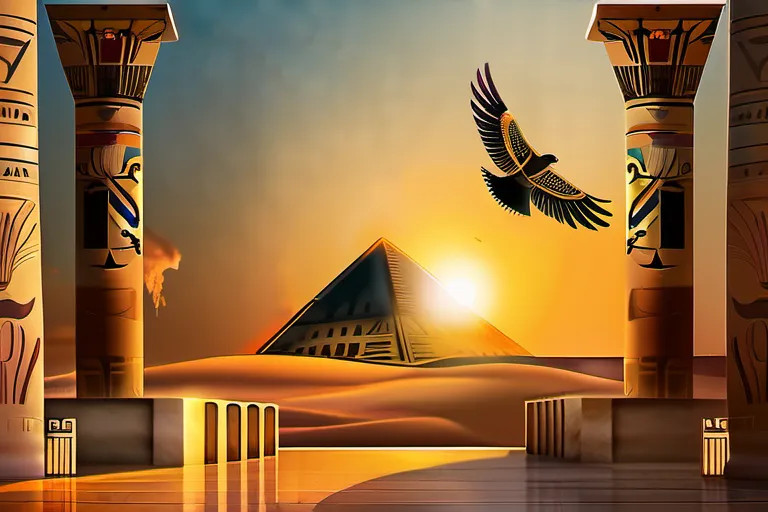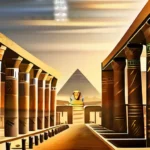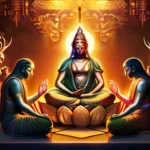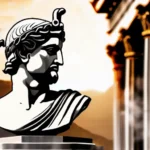Explore the beliefs, practices, and deities of Kemetism, the modern revival of ancient Egyptian polytheism.
Kemetism is a contemporary spiritual tradition that seeks to reconnect with the ancient Egyptian religion. This article provides an overview of its core beliefs, practices, and pantheon of gods and goddesses. Join us as we delve into this fascinating world and discover the rich tapestry of Kemetic spirituality.
The Origins and Evolution of Kemetism
The origins of Kemetism trace back to the ancient land known as Kemet, which translates to ‘the black land’ in reference to its fertile soil rich with the life-giving Nile River. How did this civilization, born out of the deserts and shaped by the river’s life cycle, give rise to a complex polytheistic religion that would influence cultures across the Mediterranean? What events and influences led to the revival of Kemetism in modern times?
The early pharaohs ruled with the guidance of deities like Osiris, the god of the underworld, who was said to judge souls in the afterlife. Ma’at, the principle of truth and order, was upheld through daily rituals and offerings to ensure harmony between the living and the divine realm. But as empires rose and fell, so did the practices and beliefs associated with Kemetism.
In 341 AD, Emperor Theodosius banned pagan cults in favor of Christianity, marking a significant turning point. Yet, the seeds of Kemetism were not entirely eradicated. Over the centuries, scholars and philosophers continued to explore ancient texts, preserving knowledge that would later flourish during the modern revival.
The 20th century saw an increased interest in Kemetic spirituality as scholars like Geraldine Pinch and writers like Moustafa Gadalla began reintroducing Kemetism to the public. This revival was not just about rediscovering lost rituals but about reclaiming a rich cultural heritage that had been suppressed for centuries.
Today, Kemetists celebrate their faith by engaging in practices such as offerings, ritual dances, and meditations. They honor deities like Ra, the sun god, and Isis, the goddess of love and magic, through prayers and festivals that reconnect them with the ancient traditions of their ancestors. As Kemetism continues to evolve, it serves as a reminder of the enduring power of cultural heritage in shaping our understanding of the world.
How can we better understand the complex interplay between history, spirituality, and identity within Kemetism? By exploring its origins and evolution, we uncover not just a religious practice but a profound connection to the past that continues to inspire modern believers.
Core Beliefs and Practices in Kemetism
Understanding Kemetism: An Overview of Ancient Egyptian Polytheism
In exploring the core beliefs and practices of Kemetism, one must first peel back the layers of time to grasp its essence. What exactly is at the heart of this modern revival of ancient Egyptian polytheism? Is it merely a worship of gods from millennia past, or does it hold deeper meanings that resonate in our contemporary world?
At the core of Kemetism lies ma’at, the concept of truth, balance, and cosmic order. It’s more than just a philosophical idea; it’s a way of life that guides every action and decision. How can we integrate ma’at into our daily lives, ensuring that our choices bring harmony rather than chaos?
Akuh, the principle of eternal friendship or companionship, is another fundamental belief in Kemetism. It suggests that the bond between gods and humans extends beyond death, fostering a sense of community and interconnectedness. Have you ever thought about how this concept might enrich your spiritual journey?
Heka—the power of magic or divine energy—is perhaps one of the most fascinating aspects of Kemetism. It’s not just about spells or rituals; it encompasses the belief that everything in the universe is interconnected and can be influenced by intention and will. Can you imagine a world where your thoughts and actions have the potential to create change?
The practices in Kemetism are as diverse as its deities, ranging from ritualistic offerings to meditation and divination. Each practice serves a purpose, whether it’s seeking guidance, expressing gratitude, or honoring the divine within us all. How can we honor these ancient traditions in our modern lives, making them relevant and meaningful?
As you delve deeper into Kemetism, remember that its core beliefs and practices are meant to be lived, not just studied. By embracing ma’at, akhu, and heka, you can embark on a journey of self-discovery and spiritual growth, finding harmony in the chaos of our world.
What would it take for you to embrace these ancient teachings? How might they shape your understanding of spirituality and the divine?
The Pantheon of Kemetism: Major Gods and Goddesses
The pantheon of Kemetism, like a grand symphony, features a diverse ensemble of gods and goddesses each playing their unique role in this ancient Egyptian polytheistic universe. From the powerful Ra, the sun god, who illuminates the world with his golden rays, to the nurturing Isis, whose maternal love guides lost souls, every deity adds a vital note to this cosmic melody.
Consider Ra, the primary sun god and creator of life itself. His journey across the sky each day symbolizes rebirth and transformation, much like how the cycle of dawn brings new beginnings. Ra’s attributes include light, truth, and creation, making him a cornerstone of Kemetism. How can we not see his influence in our daily lives, where sunlight guides us through both literal and metaphorical dark times?
Then there is Isis, the mother goddess who embodies love, healing, and protection. Her tales remind us that even in the face of adversity, nurturing care can be found. As a symbol of maternal devotion, Isis offers comfort and solace, much like a parent’s unwavering support during trying times. How often do we seek her blessings when facing challenges?
Traveling through this divine landscape, we encounter Anubis, the jackal-headed god of the dead and embalmment. His role in guiding souls into the afterlife underscores the importance of balance and justice. Through his guidance, Anubis ensures that the path to eternal peace is clear, much like how a lighthouse guides ships safely through treacherous waters.
Finally, there’s Bastet, the cat goddess associated with protection, fertility, and home. Her feline essence connects us to the natural world, reminding us of balance and the power of nurturing forces. How do we incorporate her teachings in our modern lives, ensuring that we protect what is dear to us?
These gods and goddesses, among others, form a rich tapestry woven with threads of life, love, light, and protection. Each deity offers insights into Kemetism’s core beliefs, providing a framework for understanding the world around us. By exploring these deities, we can gain deeper insights into the spiritual practices that define Kemetism.
Rituals and Celebrations in Kemetism
Rituals and celebrations are the heartbeat of Kemetism, the vibrant revival of ancient Egyptian polytheism. Imagine, for a moment, standing in the midst of an ancient temple, surrounded by the echoes of prayers and offerings. What rituals would you perform? How would you honor the deities who watch over your life?
Daily offerings to the gods are a fundamental practice. Just as bread and wine sustain us physically, offerings of food, incense, and libations feed the divine. These offerings keep the spirits nourished, ensuring that they remain present in our daily lives. Think about it: what would your offering be? A loaf of bread to Sekhmet, the lion-headed warrior goddess who protects against plagues and war; or a cup of wine to Isis, the mother goddess who grants wisdom and magic?
Festivals, on the other hand, are grand celebrations that honor specific deities. The most famous is likely the festival of Opet**, where Isis and Osiris were believed to journey from their sanctuary in Busir to their home in Luxor. During this time, people would gather in the streets, participate in processions, and offer prayers and gifts. Can you imagine the joy and reverence that filled the air during such a festival? How do you feel when you think about these grand occasions?
Each deity has their own festivals, dedicated to their unique roles and attributes. For instance, the festival of Horus** is celebrated at the winter solstice, where priests would perform rituals to ensure the sun’s return after the darkest days. This cycle of light and darkness mirrors the eternal struggle between good and evil in the world. How do these cycles resonate with your own life?
Through these rituals and celebrations, Kemetism brings the ancient deities into our modern lives, weaving their divine presence into the fabric of daily existence. It’s a way to connect deeply with the spiritual world while honoring the rich heritage of Kemet. So, what would your first ritual or festival be in this revival of old traditions?
Whether it’s lighting a candle for Hathor** as she watches over love and beauty, or offering incense to Thoth** for knowledge and wisdom, these practices make the divine tangible. They remind us that we are part of something greater than ourselves, connected to the past, present, and future.
In embracing Kemetism, you step into a world where the gods and goddesses are not just historical figures but living presences, guiding and protecting you every day. What rituals will you choose to bring into your life? How will they shape your understanding of spirituality?
The Role of the Priest and Priestess in Ancient Egyptian Religion
Imagine stepping into the shadowy sanctuaries of ancient Egypt, where the roles of priests and priestesses were not just religious but profound and multifaceted. These individuals held a pivotal role in maintaining the balance between the divine and earthly realms. How did they prepare to navigate this sacred path? What were their responsibilities, and what kind of training and initiations awaited them?
The journey of becoming a priest or priestess was akin to ascending a pyramid—a gradual process filled with rituals, teachings, and purifications. They started as acolytes, learning the intricacies of temple life, from tending to sacred texts to performing daily offerings. As they progressed, their knowledge grew, and so did their spiritual significance.
Initiations were not merely symbolic; they involved profound experiences that transformed candidates into vessels of divine energy. These initiations often included fasting, meditation, and the recitation of complex hymns. The sacredness of these rituals was such that participants felt a direct connection to the gods themselves.
The roles of priests and priestesses were diverse. They conducted ceremonies, interpreted omens, and provided spiritual guidance to the community. They were also healers, offering both physical remedies and psychological support. In essence, they were mediators between the divine and human realms, ensuring that life flowed smoothly within the Maat-based order.
Reflect on how these roles continue to resonate today in modern Kemetic practices. How do contemporary priestesses and priests maintain this ancient wisdom while adapting to contemporary contexts? The study of their training and initiations offers a fascinating glimpse into the enduring spiritual legacy of Kemetism, reminding us that the sacred journey is timeless.
Modern Expressions of Kemetism: Temple Building and Community
Imagine stepping into a world where the echoes of ancient wisdom and spiritual practices still resonate. This is the essence of Kemetism, a modern revival that seeks to reconnect with the rich tapestry of Kemetic spirituality. But how does this vibrant tradition manifest today? Let’s delve into the heart of Kemetic communities and their sacred spaces, the temples.
In many ways, building a temple in the 21st century is akin to constructing a bridge between the past and the present. These structures are not merely architectural marvels but living embodiments of ancient beliefs and practices. Each stone laid, each ritual performed, serves as a reminder of the enduring legacy of Kemetism.
These temples are more than just physical spaces; they are vibrant hubs where Kemetic spirituality thrives. Here, individuals come together to worship, learn, and celebrate their heritage. The formation of these communities around the world is a testament to the universal appeal of Kemetic practices. Whether in bustling cities or serene rural areas, these groups share a common bond—a connection to the divine through ancient deities like Isis, Horus, and Ra.
The rituals and ceremonies within these temples are both humbling and awe-inspiring. They involve offerings, prayers, and symbolic acts that reconnect participants with their spiritual roots. These practices serve as a bridge, allowing modern-day practitioners to experience the same profound connection that ancient Egyptians felt.
Through temple building and community formation, Kemetism not only preserves but also evolves ancient traditions. It is a dynamic practice that adapts to contemporary contexts while maintaining its core essence. As we step into these sacred spaces, we are invited to re-imagine our relationship with the divine, inspired by the enduring spirit of Kemetic culture.
So, what does your journey look like in this rich spiritual landscape? How might you contribute to or be a part of a Kemetic community and temple?
Conclusion
 In conclusion, Kemetism offers a unique perspective on spirituality that draws from ancient Egyptian wisdom. By understanding its beliefs and practices, we can gain valuable insights into the human experience and deepen our connection with the divine.
In conclusion, Kemetism offers a unique perspective on spirituality that draws from ancient Egyptian wisdom. By understanding its beliefs and practices, we can gain valuable insights into the human experience and deepen our connection with the divine.











